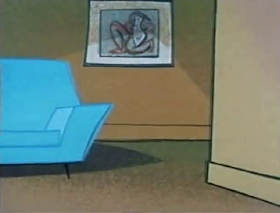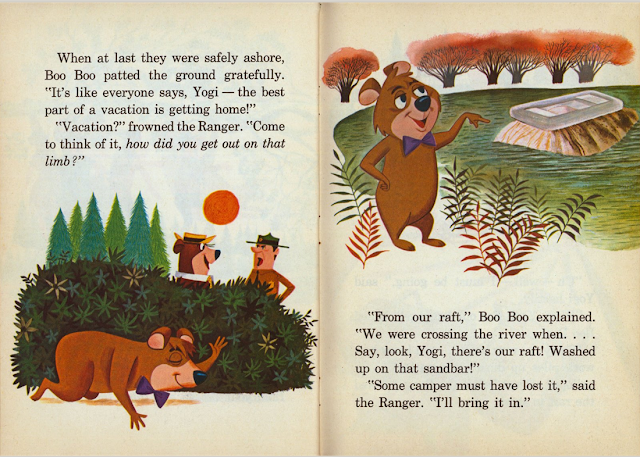![]() 59 years ago today, Bill Hanna and Joe Barbera took their MGM partnership, along with some money from film director George Sidney, and officially formed Hanna-Barbera Enterprises. Variety reported “Firm has plans for eventual theatrical cartoon features, but will do teleblurb and industrial animation work at present.” From that modest idea grew a TV empire.
59 years ago today, Bill Hanna and Joe Barbera took their MGM partnership, along with some money from film director George Sidney, and officially formed Hanna-Barbera Enterprises. Variety reported “Firm has plans for eventual theatrical cartoon features, but will do teleblurb and industrial animation work at present.” From that modest idea grew a TV empire.
Hanna-Barbera cartoons were soon seen, and loved, all over the world. As proof, here’s a story from the 1961 edition of Picture Show Annual, a British publication. It focuses mainly on Hanna and Barbera’s theatrical work although, oddly, there’s no mention of Loopy De Loop, even though the article contains two publicity drawings of the loup de Français. I really like the one with Loopy and Red Riding Hood. The outlined background and stylised Red reminds me of something from a Jay Ward cartoon; I wonder if it’s an early concept drawing by Ed Benedict.
I don’t think I’ve heard of the origin of Tom and Jerry that Hanna outlines in the story, and the relationship between Jimmy Durante and Garry Moore on their WW2-era radio show isn’t mentioned as an influence on Spike and Tyke (and, later, Augie Doggie and Doggie Daddy).The Men Behind Tom and JerryWILLIAM Hanna and Joseph Barbera, the creators of the world-famous cat and mouse, Tom and Jerry, are veterans in the field of animated cartoons.
Three years ago they branched out on their own under the banner of Hanna and Barbera Productions — they were formerly with M.-G.-M. for 20 years — located at the old Charlie Chaplin studio in Hollywood.
Oddly enough, neither William Hanna nor Joseph Barbera started his career in life as artist or cartoonist.
Hanna, born in Melrose, New Mexico, studied engineering and journalism at the University of California. His first job as a structural engineer was for the building of the Pantages Theatre in Hollywood. After falling off a girder he decided to try his luck at another profession.
At a friend’s suggestion he went to art school where he studied for several months before getting his first “ art ” job with the Harman-Ising cartoon firm. His duties were “to clean cartoon frames, sweep up the place, run errands and inspire bosses with story ideas.”
Joseph Barbera, born in New York City, went to work as an accountant for the New York’s Trust Company. He was a dreamer and a doodler, a habit which was to launch him in a new career. After many tries of submitting cartoons to magazines he managed to sell one to Collier's. Soon he became a regular contributor to such leading magazines as The New Yorker and Punch as well as Collier's.
In 1937, Bill Hanna was hired by M.-G.-M. studios as a director and story man and Joe Barbera became an animator and writer at the same studio.
As their first assignment the two men were told to create a fresh, new cartoon series for motion pictures. The result: Tom and Jerry.
William Hanna, a modest and unassuming gentleman, told me: “My partner and I got along together so well all these years that by now we seem to be like identical twins, knowing each other’s thoughts and blending our ideas together.”
“Are Tom and Jerry modelled on any particular cat and mouse?” I asked.
“On the M.-G.-M. backlot there was a whole colony of cats to keep down the population of rats. Although the studio supplied them with food, water and even milk, those cats were vicious and like wild animals. From them we got the idea of adding Butch, the alley cat. Butch’s counterpart was on the backlot, and this also is true of Tom.
“Jerry, the mouse, was a little creature that turned up at our office from nowhere — I guess he was after scraps. We encouraged him to have the run of the office by putting titbits of cheese and other tasty morsels for him to nibble. We used to watch him for weeks in all his movements and antics. “When kittens were born to the alley cats the girls in the inking department mothered them and made pets of them. Here we added models for the behaviour of Tom and Jerry.
“The bulldog idea was actually created from a little pup we called Tike. In our department we had an animator, the father of a small boy, who continually bragged about his son’s smartness. Day in and day out we had to listen to this devoted father and son relationship. My partner and I thought it a good idea to use the same formula with dogs and so Spike came into being.”
During the 20 years’ tenure at M.-G.-M. the team turned out 125 adventures of the mischievous rodent and bungling feline, which won seven Academy Awards for the studio. It was expensive to produce these cartoons which cost about £13,000 for a seven-minute run.
In 1957, with the motion picture business at an all-time low, M.-G.-M. decided to discontinue cartoon production for motion pictures and Hanna and Barbera were given release from their contracts.
This proved to be the biggest break of their lives. Together they had perfected several techniques and ideas for producing cartoons for television which they submitted to various advertising agencies and film production companies.
Everywhere they went they were met with the same answer: “It can’t be done. Good animation is too expensive; limited animation is too shoddy.”
On 7th July 1957 the two men formed the Hanna and Barbera Productions and Screen Gems took over as distributors. Their first production was Ruff ’n’ Reddy, a story about a frisky cat and a dimwitted dog, and went on an American network in 1957, followed by Huckleberry Hound, the saga of a canine Don Quixote, which is one of their most popular cartoons.
It is estimated that it takes over 90 separate drawings to create a laugh movement or a total of 10,000 individual drawing frames to make up a half-hour cartoon enjoyment.
Bill Hanna and Joe Barbera say: “We think the popularity of our cartoons lies in providing psychological release for all human beings of all ages. No one gets hurt despite clobbering and binding situations.
“We have tried to give the audience characters which they can identify with themselves — then follow up with wild antics impossible to duplicate in real life. “The adults have taken to the satire while the children watch the programmes for the face value action packed story.”
William Hanna is married and resides in North Hollywood with his wife and their two children, Bonnie, 18, and David, 21.
Joseph Barbera and his wife live in West Los Angeles. They have three children, Lynn, 21, Jayne, 18, and Neal, 15.
![]()
![]()
![]()





















































































































































































































